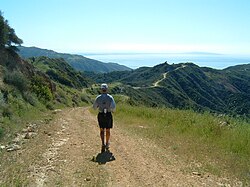Trail running


Trail running is a variant on running that differs markedly from road running and track running. Trail running generally takes place on hiking trails, most commonly single track trails, although fire roads are not uncommon. A distinguishing characteristic of the trails is that they are often inaccessible by road except at the trail heads. The trails tend to traverse varying terrain; hills, mountains, deserts, forests, and narrow passages are common. Likewise, steep inclines or rough terrain sometimes may require hiking or scrambling. Runners participating in trail runs must often descend these same steep grades. It is not atypical for trail runs to ascend and descend thousands of feet.
Trail running is growing in popularity and is enjoyed throughout the world. As of 2006, there are over 6.7 million regular trail runners in the United States, and over 40 million worldwide.[1] It has a particularly heavy following in the Mountain States, the Western US, and California.
Equipment
Most runners participating in trail running use specially designed shoes, which have nobbier and stiffer soles, and are generally more rigid and protective than road running shoes. Most athletic shoe manufacturers in the US make shoes specifically designed for trail running. The North Face, Montrail, Salomon, Inov-8 and Vasque specialize in these types of shoes. Other manufacturers like New Balance, Saucony, Brooks, and Nike also produce trail running shoes. Over 580,000 pairs of trail running shoes were sold in 2005.[2]
Other commonly used equipment include wicking garments, water bottles, sunscreen, sunglasses, gaiters, and ivy block. Some trail runners prefer to use hydration packs to carry their water, which consist of a bladder, a suck tube, and a small low profile backpack.
Trail runners can quickly penetrate deep into the back-country, however they generally carry no shelter or extra clothes, and minimal food. Without these rudiments, an injured runner could easily succumb to exposure before being helped by a passer-by. Running alone in remote wilderness means taking a serious risk, and doing so demonstrates an utter lack of wilderness survival understanding.
Training and events
Trail running takes place in both organized trail races, and as a recreational activity. Trail running is usually an individual sport, although training is commonly done in groups.
Common distances in races are 5 km, 10 km, 20 km, 30 km, Marathon (42km), 50 km, and 50 miles. Anything over Marathon distance is considered an Ultramarathon, and many "ultras" range beyond 100 mile mark. The quintessential 100 mile trail run is the Western States Endurance Run, also known as the Western States 100. There are also many Trail Running Series that combine multiple races over the course of the season. There is also a New England Trail Racing circuit, called the "Grand Tree". In Great Britain, the new "Lakeland Trails" is the biggest trail running series with over 3000 competitors in 2006.
Trail races differ considerably from other races, since runners enjoy the solitude of nature for the bulk of these runs. In addition due to the smaller number of participants, the odds of running with no other participants in sight are very good. Similarly, runners in these events must rely on their own inner resolve, since crowd support is very limited given the inaccessibility of the courses. Trail races are commonly equipped with aid stations supplying food and beverages every 5 to 10 kilometers. Nevertheless, runners in trail races, particularly longer ones, usually carry their own water and food along the course.
During training runs, carrying one's own beverages is a necessity. Additionally, navigational skills are much more important during training runs, where one invents the course oneself, compared to organized races where the courses are very well marked. Carrying maps when training in unfamiliar areas is highly recommended, as runners cover large distances and veering off course is not uncommon, especially in areas where signage is limited.
